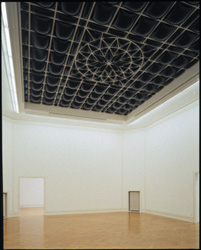Born 1969 in La Crosse, Wisconsin; lives in New York, New York
Corey McCorkle’s interest in civic infrastructure and recent utopias informs a far-ranging body of work that includes architectural interventions, installations, and the production of sculptures, photographs, and films. Like the recent design orientation evidenced by Jorge Pardo and Angela Bulloch, McCorkle’s practice responds to and acts on its environment: In Eleven Eleven (Graft) (2001), he grafted wood veneers from all over the world onto fluorescent tubes that, when lit, emit a warmly variegated glow. For 23.5 (2005) he excised and reinserted parquet floorboards to match the angle of Earth’s axis at its most extreme. Drawing from his predominantly natureinflected sensibility, marked by organic motifs, Art Nouveau–inspired patterns, and New Age points of reference, his work offers a unique acknowledgment of humanity’s imperfect (and increasingly commercially mediated) quest for enlightenment. In the potentially transcendent social spaces he creates, McCorkle— hedging our bets—“promises promise,” in the words of fellow artist Mungo Thomson.
The related projects New Life Expo (1998) and For Greater Velocity Towards Grace (1997–2002) mime the self-actualization industry, presenting circular groupings of seats for holding the lotus position—what he humorously calls “orthopedic aids for the cosmically inclined.” The artist’s tongue-in-cheek description of his work coexists with a disarming sincerity. McCorkle made the forty photographs that comprise the looped slide projection Middle of Nowhere (2002) while a resident of Auroville, a community in southern India created as a universal township and nondenominational meditative space based on a principle of “divine anarchy.” In its dedication to the transformation of consciousness and sustainable living, the town is comparable to Findhorn, a Scottish eco-village that is the subject of Untitled (Findhorn Pastoral) (2002), an installation of inkjet-print images of verdant gardens and, tattooed on the gallery walls, a wing motif taken from the site’s entrance.
More recently, McCorkle has shifted from examinations of utopian communities to studies of abandoned constructions. A dilapidated zoo on the fringe of Istanbul stands in for the region’s misplaced optimism regarding urban planning in Bestiaire (2007), a short, oddly affecting video featuring the feral dogs who freely roam the deserted site once intended to domesticate wild creatures. As a modern fable of the inevitably ruinous course of empire, Bestiaire offers a sobering counterpoint to the promises of Auroville and Findhorn—but McCorkle’s point might be that nostalgia is better than regret. SUZANNE HUDSON
Corey McCorkle, Crystal Chain Letter Complex (Dark Episode), 2005 (installation view, Kunsthalle Bern, 2005). 240 opaque blown-glass panels, 348 x 246 in. (884 x 625 cm) overall. Collection of the artist
























